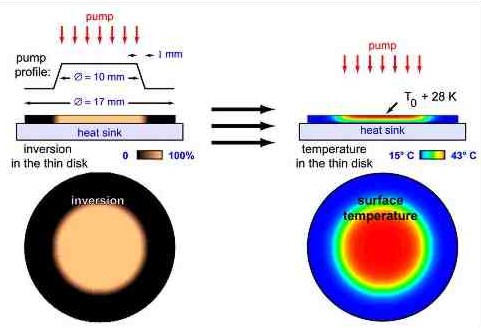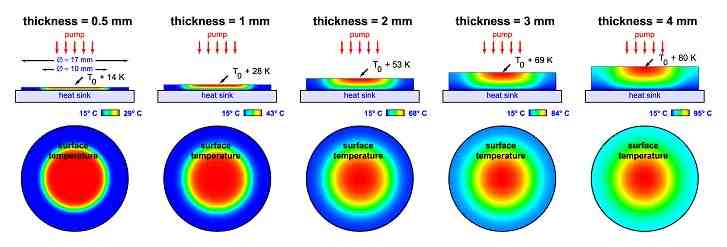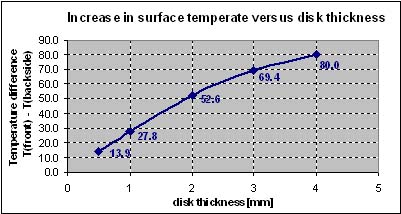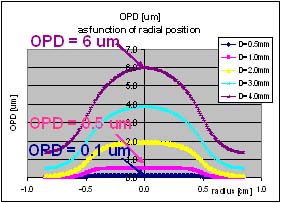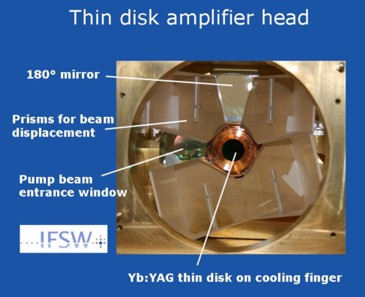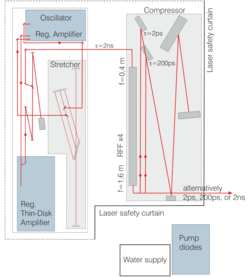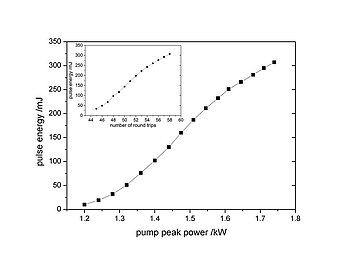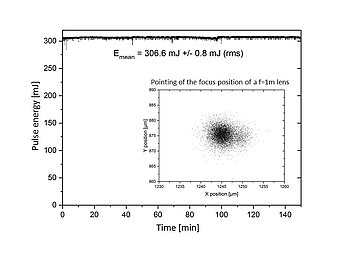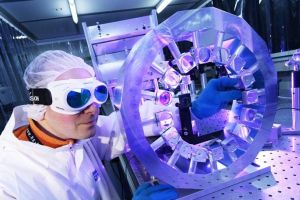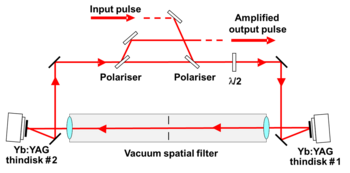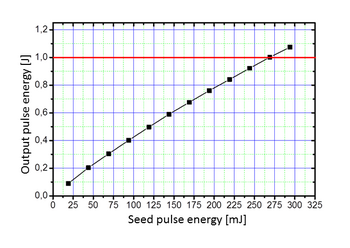Thin disk laser
The thin-disk laser technology allows for lasers with high pulse energy (several hundred mJ to Joule level) and repetition rates of up to the kHz level. A disk with a thickness between several 100 μm and 1 mm is used as the active medium. Compared to laser rods, the cooling efficiency of thin disks is much better, which allows for a higher repetition rate. The output energy is in principle scalable with the disk diameter.
We have worked on the development of thin-disk lasers since several years. The goal was a system delivering laser pulses with > 1 J at a repetition rate of 100 Hz and a pulse duration of a few ps. We have reached these parameters in 2015.
At present, we are concentrating on optimizing our thin-disk lasers for several applications. One system is used as a driver for an incoherent laser plasma source emitting in the wavelength range from several 100 eV to the keV level. An other system is used as pump source for an OPCPA system being developed to generate few fs pulses with energy up to 40 mJ. Both systems use diode-pumped Yb:YAG disks as the laser material in combination with CPA technology. The systems work at 100 Hz repetition rate emitting 2 - 5 ps pulses with up to 300 mJ pulse energy.
In the next paragraphs the basic principle of thin-disk technology is explained and the setup of the two laser systems used for soft x-ray generation and as pump laser for the OPCPA system is described. Some significant results of our thin-disk laser development are presented in the final paragraph.
Thin-disk technology compared to conventional lasers
In conventional lasers using laser rods as active material the heat dissipation is a major challenge. Cooling the rod via its surface is rather inefficient due to the large volume to surface ratio. Additionally, it generates an temperature gradient perpendicular to the laser axis which results in thermal lensing. The use of a thin disk that is cooled from one side instead of a rod is the logical step towards better cooling and consequently higher average output power. Since a thin disk shows a much lower amplification than a thick rod it is important to find the best compromise between high amplification and good cooling efficiency. The following numerical simulation gives an overview on how to find the right disk thickness.
Numerical simulation of thin disks
We have numerically calculated the temperature distribution in thin disks by solving the heat equation in three dimensions. The real pump parameters of our laser setup were used as the starting parameters. The disk is pumped from above and cooled from below:
- Absorbed intensity during pumping: Iabsorbed = 5 kW/cm2
- Duration of the pump pulse: tpump = 1 ms
- Repetition rate: f = 200 Hz
- Wavelength of the pump radiation: λ = 940 nm
- Quantum defect d = 8 %
The figure below shows the simulated setup. The pump radiation of 5 kW/cm2 was focused in a pump spot of 10 mm diameter from the top on the thin disk. The latter is in thermal contact to a heat sink.
In our simulation, disks of various thicknesses were pumped in such a manner that the energy stored in the disks is identical. The following figure shows the temperature profiles obtained for various thicknesses of the disk. The plot below depicts the increase of the temperature at the front surface compared to the cooled back surface of the disk. Despite of the identical stored energy in the disks, the temperature difference between front surface of the disk and its cooled back side increases strongly with the thickness of the disk. One can see that the temperature difference between the front side and the cooled back side of the disk amounts to only 14 deg for the 0.5 mm thick disk used in our amplifiers, while this difference would exceed 80 deg for a hypothetical 4 mm thick disk.
For use of the thin disks as amplifying elements, the wavefront perturbation due to the Optical Path Difference (OPD) is the most important number. The figure below shows the result: While the OPD is in the order of 0.1 μm for the 0.5 mm disks used in our amplifier, an OPD of 5 μm would be obtained for a very thick disk of 4 mm thickness.
The simulations show clearly, that disks with a thickness between 0.5 an 1 mm should be used in the setup of our amplifiers.
Implementation and design of thin-disk lasers
The key element of a thin-disk amplifier is of course the thin laser disk installed in a cooling finger. The disk has an anti-reflection coating on its front side and a high reflection coating on its back side. The back side is attached onto a water cooled heat sink. Therefore, the cooled surface is very large compared to the pumped volume and additionally the temperature gradient is parallel to the incident laser light, reducing the thermal lens effect. Due to the efficient cooling thin-disk technology is one of the promising choices for high repetition rate laser systems. This technology is known for its very good beam quality. It is used in industrial lasers and extremely stable and reliable operation has been demonstrated. Besides the well prepared thin-disk the other key element is the pumping head. It it designed in a multipass geometry that the pump light is guided several times onto the laser disk. Since the disk has a thickness of the order of 500 μm a single pass absorption would be around only 25 %. Fig. 4 shows a sketch of a pump module.
The laser disk is surrounded by a number of prisms. In front of the disk a large parabolic mirror images the exit of the pump diode fiber magnified onto the laser disk. A fraction of the pump energy is absorbed on its way to the back side of the disk. Here the remaining part is reflected and partly absorbed on its way out of the disk. The prisms around the disk displace the pump beam and guide it back to the disk. Nearly 100% of the pump light can be absorbed with this geometry.
In principle, thin-disk technology is scalable in pulse energy by enlarging the pump energy proportional to the pump beam size on the laser disk and keeping the pump intensity at a constant level. This of course requires also disks with appropriate diameter. An important part of the project was therefore the development of bonding methods of large disks to an appropriate heat sink.
System set up
Two Yb:YAG thin-disk laser systems are presently operated in the framework of this projekt:
- One of them is used for driving an OPCPA system.
- The other system is utilized as a pump laser for a soft x-ray plasma source.
Both laser systems have a similar layout. They consist of a front-end with an Yb:KGW oscillator, a grating stretcher, and an Yb:KGW regenerative amplifier. The front-end delivers laser pulses stretched from about 200 fs to 2 ns with 0.5 mJ of pulse energy. These laser pulses are further used to seed a regenerative amplifier based on Yb:YAG thin-disk technology.
For pumping the OPCPA system the laser pulses from the front-end are split to seed two regenerative thin-disk amplifiers. The two amplified laser pulses are then compressed to 6 ps - 7 ps and converted to 515 nm wavelength. Further information can be found on the web-side of project 4.1.
For the soft X-ray source the laser pulses from only one regenerative amplifier are used. Depending on the required soft X-ray spectrum the amplified pulse can be compressed to 2 ps or 200 ps or it can used uncompressed with 2 ns pulse duration. The pulse energy can be as high as 180 mJ at 100 Hz repetition rate. Fig. 7 shows the setup of the system.
Regenerative Amplifier
The heart of the amplifier is the thin-disk pump module. The Yb:YAG amplifier disk is mounted on a cooling finger. The cooling finger as well as the Yb:YAG disk are manufactured by TRUMPF GmbH. The complete back side of the disk is water cooled, which guarantees efficient cooling and a low thermal lens effect. By use of a large spherical mirror in front of the disk and some displacement prisms the pump beam is guided 6 times onto the Yb:YAG disk (12 passes through the disk) to be absorbed nearly completely. The amplifiers are pumped by fibre coupled laser diodes at a wavelength of 940 nm. The diodes can be operated with a duty cycle of up to 20%. This corresponds to a repetition rate of up to 200 Hz with a pump pulse duration of 1 ms or 800 Hz with 0.25 ms pump pulse length. The diodes were specially developed at Ferdinand Braun Institut (FBH) as a pulsed pump source for Yb:YAG.
In the resonator of the regenerative amplifier the Yb:YAG thin disk is used as one end-mirror. Additional spherical mirrors in the cavity are used to adjust the beam diameter on the disk to the pump beam diameter. Fig. 10 shows a sketch of a typical setup of the regenerative amplifier.
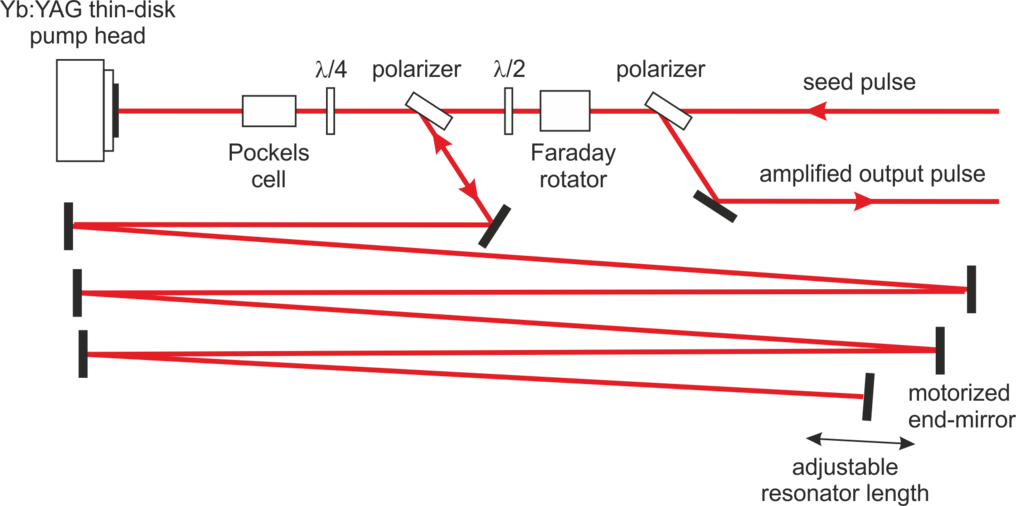
Fig. 11 shows the output pulse energy vs. pump power for a regenerative amplifier. A maximum output energy of 307 mJ could be extracted at a pump power of about 1.75 kW and 56 round-trips. This corresponds to an optical-to-optical efficiency of more than 17%. An excellent stability below 0.3% rms (s. Fig. 12) was measured over a period of about 2.5 h. The output beam is highly collimated. An M2 measurement resulted in a value of better than 1.2 with a minimum focal spot size of 80 μm at f = 300 mm. The pointing stability behind a f = 1 m lens is +/- 2 μm (rms), measured over 30 min.
Booster Amplifier
Further amplification of the laser pulse is done by a multipass or a ring amplifier. Several multipass geometries have been investigated. Laser pulses with more than 500 mJ pulse energy could be demonstrated with these multipass amplifiers. During several years one system delivering 400 mJ on a daily basis was running as driver for the X-ray laser from project 3.3.
The main drawback of multipass amplifier systems is the high optical quality required for the laser disk. A not perfect disk distorts the beam on every reflection a bit more. Usually, after 4 or 5 reflections (amplification steps) the beam cannot be further amplified. An adaptive mirror that compensates the distortions induced by the disk or a spatial filter cleaning the laser beam is required for a better performance. Therefore we have also set up a ring amplifier with integrated spatial filter. A schematic sketch is given in Fig. 14. The laser pulse is injected via a polarizer. A halfwafe-plate rotates the polarization in such a way that the pulse stays for two round-trips in the amplifier. The amplifier is equipped with two amplifier heads. Therefore, in total we have 4 amplification steps within the amplifier. Between the two amplifier heads a spatial filter is installed.
With this kind of amplifier the laser pulses were amplified to more than 1 J pulse energy at 100 Hz repetition rate. The seed pulse energy from a regenerative amplifier was 300 mJ. Fig. 15 shows the amplification curve of the system.
Summary and Outlook
Due to the high cooling efficiency and low thermal lens effect the thin-disk technology is the promising approach for lasers with high pulse energy and medium repetition rate. We have developed a diode pumped CPA laser system based on Yb:YAG thin-disk technology as a driver for an X-ray laser as well as a pump laser for OPCPA.
Pulse energies of more than 1 J have been reached on an experimental basis. For daily operation about 400 mJ pulse energy (ns pulse) corresponding to 300 mJ in a compressed ps pulse could be used.
The regenerative amplifier shows a very good stability of better than 0.3% (rms) measured over a period of several hours as well as an excellent beam quality with M2 better than 1.2. Such a system was also constructed for the Institut de la Lumière Extrême (ILE) as part for the 10 Petawatt short pulse laser system APOLLON.
Since thin-disk technology is in principle scalable in output energy a further increase into the multi Joule level should be possible. Large Yb:YAG disks with more than 25 mm in diameter must be developed to increase the output pulse energy. The bonding technology in order to contact such large disks to an appropriate heat sink is one of the main tasks. Since the optical quality of the amplifier medium is very critical for thin-disk laser amplifiers this is one of the most important subjects.
Collaborations and Funding
Ferdinand Braun Institute (FBH)
Trumpf Lasertechnik GmbH
Institut de la Lumière Extrême (ILE)
Institut für technische Physik der DLR
Institut für Strahlwerkzeuge (IFSW), Uni Stuttgart 
WGL
ELI
Laserlab Europe
